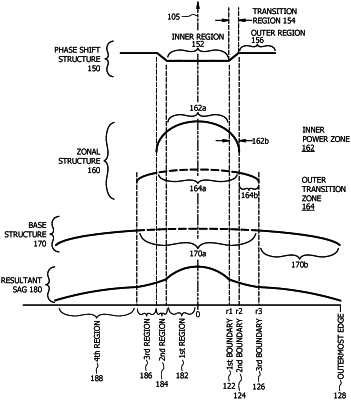| CPC A61F 2/1627 (2013.01) [A61F 2/164 (2015.04); A61F 2/1616 (2013.01); A61F 2/1632 (2013.01)] | 30 Claims |

|
1. An ophthalmic lens, comprising:
an optic having an anterior surface and a posterior surface disposed about an optical axis, at least one of the anterior and posterior surfaces having a composite multi-layered surface profile corresponding to a superposition of at least three profiles comprising a phase shift structure, a zonal structure, and a base structure:
the phase shift structure characterized by an inner region, an outer region, and a transition region, wherein,
the inner region extends radially from the optical axis to a first boundary;
the transition region is disposed between the inner region and the outer region and extends radially from the first boundary to a second boundary, wherein the transition region is adapted such that a phase of radiation incident thereon varies linearly over at least a portion of the radial extent between the first boundary and the second boundary so as to generate a phase shift between the first and second boundaries, the second boundary disposed at a radial distance further from the optical axis than the first boundary; and
the outer region extends radially from the second boundary towards an outermost edge of the optic;
the zonal structure having an inner power zone having a first curvature and an outer transition zone having a second curvature, the inner power zone extending radially from the optical axis to the second boundary, and the outer transition zone extending radially from the optical axis to a third boundary, the third boundary disposed at a radial distance further from the optical axis than the second boundary; and
the base structure having a base curvature extending radially from the optical axis to the outermost edge of the optic.
|